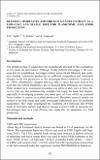| dc.contributor.author | EO Ogello, Stenly Wullur, A Hagiwara | |
| dc.date.accessioned | 2020-08-21T09:34:46Z | |
| dc.date.available | 2020-08-21T09:34:46Z | |
| dc.date.issued | 2017 | |
| dc.identifier.uri | https://repository.maseno.ac.ke/handle/123456789/2265 | |
| dc.description.abstract | The global increase of aquaculture has expanded the demand for the zooplankton as live foods for larviculture. Although freshly cultured microalgae is the common diet for zooplankton, microalgal culture protocols are laborious and costly, thus limiting continuous production of sufficient zooplankton and sometimes disrupts larval fish production in the microalgae-based hatcheries (Lubzens et al., 1995). Alternatively, cheaper diet (e.g. baker’s yeast) has been used as live food diet but culture instabilities due to bacterial flora imbalance are common. Other products (e.g. condensed microalgae and artificial diets such as Selco (Inve- Co. Ltd) are also commercially available but costly for most fish farmers, especially in developing countries and some parts of Asia, which are potential future leaders in marine larviculture production. Therefore, research studies are needed to develop cheap and stable microalgal replacement diets for profitable aquaculture. This study investigated the feasibility of a fishwaste diet (FWD) made of fishwastes (heads) and chicken manure extract (CME) at optimum carbon/ nitrogen ratio as a cost-effective and stable diet for planktonic live food production. | en_US |
| dc.publisher | Ghent University, Belgium | en_US |
| dc.subject | S Agriculture ; SH Aquaculture; Fisheries; Angling | en_US |
| dc.title | BLENDING FISHWASTES AND CHICKEN MANURE EXTRACT AS A LOW-COST AND STABLE DIET FOR PLANKTONIC LIVE FOOD PRODUCTION | en_US |

